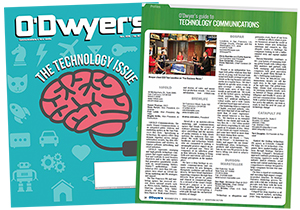This is where strategic content marketing writing comes into play. This article is featured in O'Dwyer's Nov. '16 Technology PR Magazine Aside from that, many tech companies are missing the boat by overlooking the importance of content marketing writing as a key element in their PR programs. Or they’re delegating content marketing writing solely to their marketing and sales operations and distinctly separate from PR. Generally, in the high-tech world, marketing/sales operations stay distant from PR, allowing them limited time to source new product announcement information. Fueling content marketing A high-tech company, regardless whether it’s a giant or a start up, must continue to educate its audiences or personas as referred to today. Social media definitely plays a role in a high-tech PR and con- Dan Garza tent marketing strategy. Neil Patel, writing for the Content Marketing Institute in May, said, “Long-form content as opposed to “snack-able” content is what fuels a successful con-tent marketing approach.” In the high-tech world, subject matter is dynamic and generally never static. Some marketing and PR pros are prone to first go to social media to try to get their educational content to targeted customers. Circle closer toward purchase On the other hand, when a new technology or enhanced versions of an earlier technology is ready to be launched, the PR pro comes out with both guns blazing after crafting the right content marketing strategy. For example, the stage can be set out in time for a major product or technology launch to condition prospective and existing customers to more favorably accept the new product or technology.
Ideally, the objectives of a high-tech PR operation are to create market awareness, company and technology visibility, customer trust, business value, credibility, reputation and pave the way for more effective sales. In particular, you need the long-form of content as a content marketing platform to set a foundation for an overall strategic PR communications program.
This is where strategic content marketing writing comes into play. Properly performed and executed, content marketing writing helps to achieve those objectives. On the other hand, in many cases, marketing and sales take the tactical rather than strategic approach. In effect, they periodically shovel out random pieces of content to satisfy immediate requirements, instead of performing strategic content marketing on a sustained, organized manner.
 |
Aside from that, many tech companies are missing the boat by overlooking the importance of content marketing writing as a key element in their PR programs. Or they’re delegating content marketing writing solely to their marketing and sales operations and distinctly separate from PR. Unfortunately, when you separate the two, both entities are less effective. Here’s why:
When content marketing writing is left to marketing, it has a great probability of being polluted given the nature and mindset of marketing and sales in many companies. Generally, that’s because they have a penchant for hyperbole and the classic sales pitch kind of writing. The first thing these individuals want is to promote the product or technology. Content takes on a promotional and hype flavoring that is often annoying and turns customers off simply because they constantly experience product hype so much.
Generally, in the high-tech world, marketing/sales operations stay distant from PR, allowing them limited time to source new product announcement information. Sometimes, that’s done via brief emails touting new features, and leaving the PR pro to craft the press release.
Also marketing and sales often lacks a content strategy and relies heavily on specific and random sales tools they often feel will work for them, such as advertisements, email, social media, etc.
Most often, marketing and sales produce company-centric content, rather than the more vital customer-centric content. Studies show that prospects come to websites searching for answers to their hardware or software issues. This is where journalistic customer-centric content plays a major role, and the burden should be on the PR pro to provide this valuable marketing content.
However, in some cases, the inexperienced PR or Communications Chief solely relies on the company’s CEO’s “vision” and adopts it as the content strategy without involving marketing and sales. The issue here is that the CEO’s company-centric Vision might indeed be an effective roadmap of how his/her company evolves. However, it’s definitely not customer-centric, and at best, it’s a faux content strategy since marketing and sales customer input is missing.
Improperly defining a content strategy is related to the misguided or ill defined one described above. To be effective, a correct content strategy must be in sync with and not divergent from a well-defined business strategy.
Another obstacle is focusing solely on tactical marketing…
COMMENTS